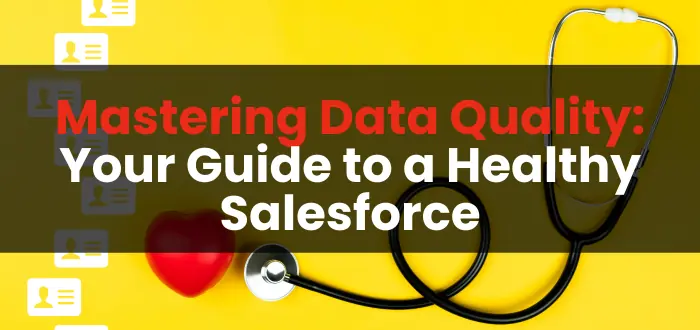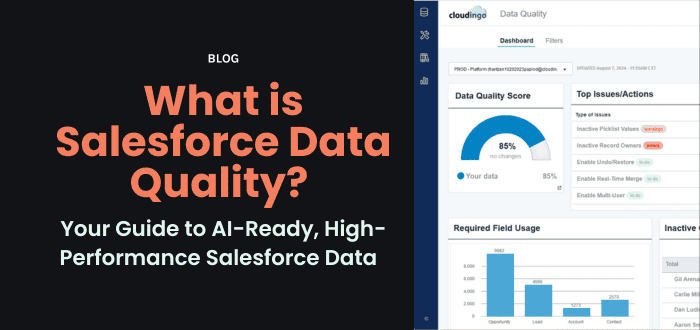January 16, 2024
Mastering Data Quality: Your Guide to a Healthy Salesforce

Data is the lifeblood of your business, and nowhere is this truer than in Salesforce, your CRM hub. Accurate, reliable data fuels insightful reports, targeted campaigns, and informed decisions. But what happens when your data is riddled with inaccuracies, duplicates, and inconsistencies? It's like trying to navigate a map covered in water stains – you'll end up lost in a sea of misinformation.
That's where data quality comes in. It's the key to unlocking the true potential of your Salesforce, transforming it from a data swamp into a clear, flowing spring of insights.
This guide will equip you with the knowledge and strategies to take charge of your data health and maximize the effectiveness of your Salesforce.
Step 1: Diagnose the Disease - The Data Audit
First things first, you need to understand the extent of the problem. Conduct a thorough data audit to identify issues like:
- Duplicates: Multiple records for the same contact, lead, or account.
- Inaccuracies: Incorrect email addresses, phone numbers, or other information.
- Incompleteness: Missing values in key fields.
- Inconsistencies: Variations in formatting or naming conventions.
Step 2: Prescribe the Remedy - Define Data Standards
Once you've diagnosed the problems, it's time to set the rules of the game. Define clear data quality standards across your organization, covering aspects like:
- Field formats: Standardize email addresses, phone numbers, and other data types.
- Validation rules: Implement rules to ensure data accuracy during entry.
- Naming conventions: Establish consistent naming for entities like accounts, contacts, and opportunities.
Step 3: Treat the Patient - Implement Data Governance
Data quality isn't a one-time fix. It requires ongoing care and attention. Implement a data governance framework to:
- Assign data ownership: Delegate responsibility for specific data fields or entities.
- Establish data stewards: Appoint individuals who monitor and champion data quality.
- Create data quality processes: Define workflows for data cleansing, deduplication, and ongoing maintenance.
Step 4: Perform Surgery - Cleanse and Deduplicate Data
Now it's time to take action! Tools like Cloudingo can help you:
- Identify and merge duplicates: Eliminate data redundancy and ensure consistency.
- Correct inaccuracies: Cleanse data by fixing errors and missing values.
- Optimize data integrity: Standardize formats and eliminate inconsistencies.
Step 5: Preventative Care - Enforce Validation Rules and Automation
Make data quality a continuous habit, not a one-time effort:
- Leverage Salesforce validation rules: Ensure real-time accuracy during data entry.
- Automate data cleansing: Schedule regular tasks to maintain data hygiene or merge records in real-time.
- Set up data quality alerts: Be notified of potential issues proactively.
Step 6: Continuous Checkups - Monitor and Analyze Data Quality Metrics
Just like monitoring your health, track your data health through key performance indicators (KPIs). Tools like Cloudingo can help you:
- Measure data completeness and accuracy.
- Track duplicate rates and deduplication progress.
- Identify areas for improvement based on data insights.
Remember, data quality is an ongoing journey. By implementing these strategies and adopting a proactive approach, you can transform your Salesforce into a reliable source of truth, driving confident decision-making and propelling your business forward.
Cloudingo can be a valuable partner in this journey. Our data quality solutions empower you to take control of your data and unlock the full potential of your Salesforce. We invite you to try out Cloudingo for a 10-day free trial. Immediately see how many duplicates you have inside Salesforce and so much more.
Embrace data quality and watch your Salesforce blossom into a robust, thriving hub of valuable information.






